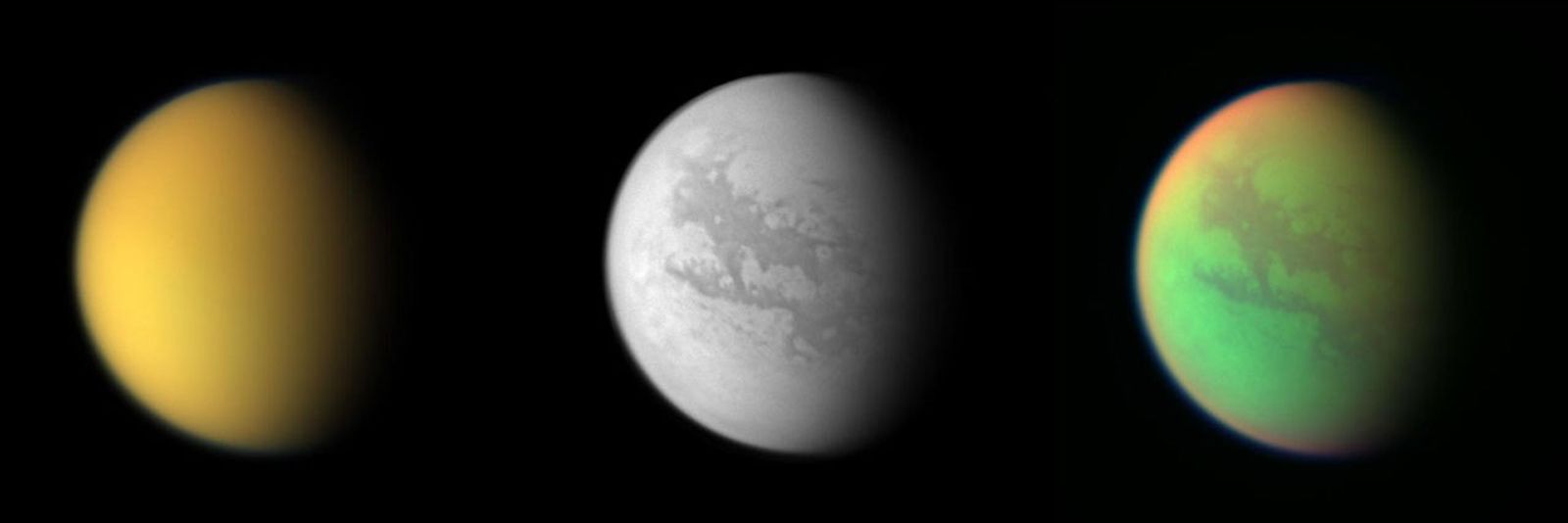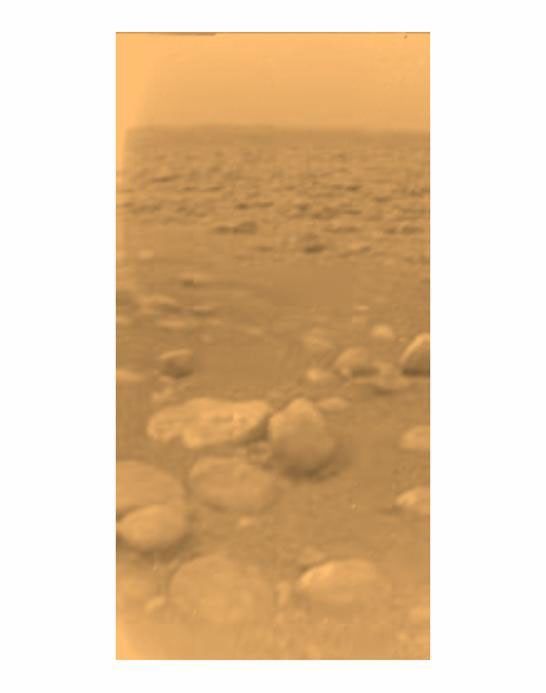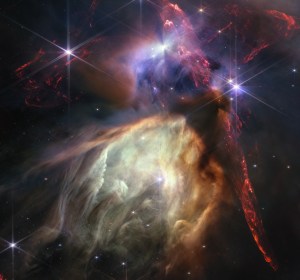NASA is preparing to send the drone-like Dragonfly to the intriguing moon, Titan. Here are five reasons Saturn's largest moons is so enticing.

Titan, with its methane seas and orange smog, is in some ways the most similar world to Earth that we have found. Though it’s merely a moon tethered by gravity to its cosmic ruler, Saturn, Titan has all the trappings of a planet, including clouds, rain, lakes and rivers, and even a subsurface ocean of salty water.
Dutch astronomer Christiaan Huygens discovered Titan in 1655, calling it simply “Luna Saturni,” or Saturn’s moon. It was later renamed after a group of mythological Greek deities called Titans.
The true nature of this largest of Saturn’s moons was inscrutable until NASA’s Cassini spacecraft made 127 close flybys of Titan over 13 years spent exploring the Saturn system. Cassini also dropped a European Space Agency spacecraft called Huygens through Titan’s atmosphere in 2005, finally lifting the veil on this magnificent moon.
Now, NASA is preparing to send the drone-like spacecraft Dragonfly to dig further into a world that has become one of the most important targets of exploration. Here are five reasons Titan is so enticing:
NASA's Goddard Space Flight Center/Johns Hopkins University Applied Physics Laboratory
1) It’s the only moon in our solar system with a thick atmosphere
An atmosphere is an envelope of gas molecules that swaddles a celestial body. Here on Earth, our atmosphere protects us from the Sun’s radiation; it also helps maintain and circulate heat and distribute gases that nourish life.
Moons have atmospheres too, but in all but one case they’re so thin they’re barely there. Among the solar system’s many moons, Titan’s atmosphere is … well, a titan. So thick and opaque is the moon’s atmosphere — four times denser than Earth’s — it obscured Titan’s true size for centuries. Indeed, Titan was considered the largest moon until Ganymede, about a third of Earth’s size and only 2% larger than Titan, snatched that record.
In 1944, Dutch-American astronomer Gerard Kuiper used a powerful new telescope to discover that Titan was wrapped in gas. But it wasn’t until Cassini dispatched the Huygens probe through Titan’s atmosphere that scientists finally saw in detail the surface of a world that had been shrouded in mystery for 350 years.
Titan’s dense atmosphere offers a key benefit to scientific exploration, especially combined with its low gravity (1/7th of Earth’s) and frigid temperatures (-290 Fahrenheit, -179 Celsius, 94 Kelvin). These three features will help Dragonfly stay easily aloft above Titan’s surface and to fly faster and farther with little energy. In fact, Dragonfly is expected to fly more than 100 miles (160 kilometers) over a nearly three-year mission — that’s almost double the distance traveled by all the Mars rovers combined.
2) Its atmosphere is more similar to Earth’s than any other
Titan’s atmosphere is made mostly of nitrogen (about 95%), like Earth’s (78%). It also contains about 5% methane, plus a hint of other carbon-rich compounds.
A notable difference between the two worlds is oxygen, which is absent on Titan, but makes up 21% of Earth’s air. But this wasn’t always so. When microbes ruled this planet 3.8 to 2.5 billion years ago, there was no oxygen here; instead, the air was filled with methane that was produced by these simple microorganisms that quietly flourished in the oceans. Some scientists suspect that at times the methane helped form an opaque orange haze around Earth just like it does on Titan. In fact, this shroud may have helped nurture life on our planet by keeping Earth temperate and by screening out much of the harmful ultraviolet radiation from the Sun that can break down DNA. It also may have provided nutrients if microorganisms could metabolize the organic particles that fell out of the air.
Could Titan look a lot like Earth did billions of years ago? Scientists think so. They’re eager to learn through Dragonfly whether the chemistry that transpires in Titan’s atmosphere is similar to the chemical processes that shaped Earth’s air.

3) There’s intriguing chemistry happening there
It takes only two ingredients in the atmosphere — methane and nitrogen — to unleash a complex web of organic chemistry that makes Titan unique and interesting to scientists. After radiation from the Sun splits each of these molecules apart, their component atoms of carbon, hydrogen and nitrogen can recombine to form a variety of complex organic compounds that settle on the surface. Called “organic” because they contain carbon, these types of molecules are the building blocks of life on Earth. Thus, scientists are eager to see which compounds are on Titan and whether they are similar to the ones that could have seeded life on Earth.
Whether microbial life exists on Titan is an intriguing question for scientists. On the one hand, there’s an important ingredient conspicuously missing from the moon’s surface: liquid water. On Earth, liquid water is critical to life, given that it lubricates molecular processes and distributes nutrients, among other attributes.
On the other hand, scientists haven’t ruled out that Titan’s liquid methane environment might lend itself to exotic life forms. After all, scientists know that microorganisms on Earth can live in the most extreme environments imaginable, including in areas with well below freezing temperatures, high radiation, and little to no water. Could similar creatures survive the hardships of Titan?
4) It’s a real-time science experiment that can’t be reproduced in a lab
Scientists are still working to understand how life started on Earth when the planet was about a billion years old. Many have sought to learn more by recreating Earth’s primordial conditions in their labs. Time and again, they try to spark the chemical reactions that turned the molecular soup of young Earth into a sea of living creatures. But life’s drawn-out timescale is too long for lab experiments.
That’s where Titan comes in. Many scientists believe that the moon could be a virtual laboratory for prebiotic chemistry that’s been ongoing for ages. When Dragonfly arrives on Titan in 2034, it will pick up the results of these experiments at several locations on the moon’s surface with a variety of geologic histories. The spacecraft will end its mission at the Selk impact crater, where plentiful organic compounds could’ve mixed with past liquid water for extended periods of time to create conditions that, at least on Earth, could have supported life.
5) It reminds us of Earth, but with some curious twists
Titan’s terrain, and even its landscape, looks eerily similar to Earth’s. On closer inspection, though, every familiar feature has an exotic trait.

Dragonfly’s landing site in the equatorial region called Shangri-La, for instance, features dunes that could easily be confused with those of Namibia, a country in southern Africa. These mountains of sand in Namibia rise up to 1,000 feet (300 meters). On Titan, the tallest dunes found appear to be upwards of 300 to nearly 600 feet (100 to 175 meters). But, instead of sand, the dunes are made of dark hydrocarbon grains, or bits of frozen methane and ethane that might resemble fine coffee grounds.
There are other spectacular similarities: Like Earth, Titan is carved by flowing rivers and lakes, and seas named after mythical sea creatures. But these bodies of liquid, some as big as North America’s Great Lakes, are made of methane instead of water. As the gas flows across the surface, wearing away rocks along its path, it produces hills and valleys that are reminiscent of those in White Canyon, Utah and Guangxi, China.
The rocks strewn about Titan’s surface look familiar, too. Yet they’re made of water ice that stays frozen solid in the moon’s unfathomably cold weather. Scientists also suspect that Titan may have had active volcanoes, but that they spewed liquid water “lava” instead of molten rock. From Titan’s surface, one might feel at home at the sight of clouds in the sky above. Yet, instead of water, they sometimes drench Titan’s surface with methane rain.
Lonnie Shekhtman is a senior science writer at NASA’s Goddard Space Flight Center, Greenbelt, Md.
Read More
- Dragonfly Mission Profile (NASA)
- Dragonfly Mission Homepage (Johns Hopkins University Applied Physics Laboratory)
































